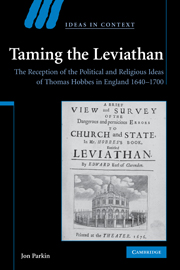 Taming the Leviathan
Taming the Leviathan Book contents
- Frontmatter
- Contents
- Acknowledgements
- Introduction
- 1 Reading Hobbes before Leviathan (1640–1651)
- 2 Leviathan (1651–1654)
- 3 The storm (1654–1658)
- 4 Restoration (1658–1666)
- 5 Hobbes and Hobbism (1666–1675)
- 6 Hobbes and the Restoration crisis (1675–1685)
- 7 Hobbism in the Glorious Revolution (1685–1700)
- Conclusion
- Bibliography
- Index
- Ideas in Context
Introduction
Published online by Cambridge University Press: 05 May 2010
- Frontmatter
- Contents
- Acknowledgements
- Introduction
- 1 Reading Hobbes before Leviathan (1640–1651)
- 2 Leviathan (1651–1654)
- 3 The storm (1654–1658)
- 4 Restoration (1658–1666)
- 5 Hobbes and Hobbism (1666–1675)
- 6 Hobbes and the Restoration crisis (1675–1685)
- 7 Hobbism in the Glorious Revolution (1685–1700)
- Conclusion
- Bibliography
- Index
- Ideas in Context
Summary
In 1640 Thomas Hobbes of Malmesbury, the 52-year-old secretary to the Earl of Devonshire, had a minor reputation as a respected translator and pastoral poet. To a small number of his friends he was also known as a promising mathematician and natural philosopher, perhaps even England's answer to Descartes. By 1700 all of this had changed. Hobbes had an international reputation, but not as an acclaimed scientist. Indeed, that reputation lay largely in ruins. He was widely known as the most notorious philosopher that England had ever produced. His name had become a byword for atheism, immorality and a whole range of unacceptable political views. To his English readers, he was the ‘Monster of Malmesbury’, the ‘Devil's Secretary’, an ‘Agent of Hell’ and as one writer put it ‘Nature's Pest’ and ‘unhappy England's Shame’. By the end of the century Hobbes had managed to acquire an extraordinary and perhaps even unique place in the English imagination as the bête noire of his age.
The remarkable transformation of Hobbes's public image from 1640 to 1700 was the effect of over fifty years of hostile commentary on Hobbes and his works. The dominant attitudes to Hobbes were largely structured by his critics, who were numerous and sometimes organised. Their success in blackening Hobbes's reputation was such that their view of the philosopher as a misanthropic atheist profoundly influenced subsequent readers and still informs popular understandings of Hobbes's ideas today.
- Type
- Chapter
- Information
- Taming the LeviathanThe Reception of the Political and Religious Ideas of Thomas Hobbes in England 1640–1700, pp. 1 - 17Publisher: Cambridge University PressPrint publication year: 2007
- 1
- Cited by
